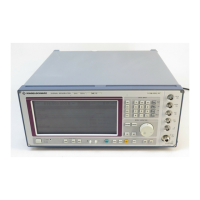Test Procedure SME
1038.6002.02 5.28 E-13
5.2.32 Pulse Modulation (Option SM-B3/B8/B9)
5.2.32.1 ON/OFF - Ratio
Test equipment - Spectrum analyzer (Section 5.1, item 2)
- Pulse generator (Section 5.1, item 17)
Test setup To determine the ON/OFF ratio, connect a spectrum analyzer to the
RF output socket of the SME and a pulse generator to socket PULSE
at the rear panel of the SME.
Measurement
À Setting at the SME
- Select EXT in the MODULATION/PULSE/SOURCE menu.
À Determine the output level of the SME with a present "high" and
"low" signal with various carrier frequencies
Difference of the output level with a "high“ and "low" signal
...........................................................................................>80 dB
5.2.32.2 Dynamic Characteristics
Test equipment Test system 5.1.1.4
Measurement
À Simultaneously display the input signal from the pulse generator
and the (down-converted) output signal on the dual-trace
oscilloscope (triggering on the input signal).
À Settings at the pulse generator
- Square-wave pulse sequence at a frequency of approx. 10 MHz,
TTL level.
À Settings at the SME
- Carrier frequencies > 50 MHz
- with option SM-B3: level 10 dBm.
- with option SM-B8: level 9 dBm.
- with option SM-B9: level 8 dBm.
À With carrier frequencies > 50 MHz, use mixer and set an IF of
approx. 50 MHz using the auxiliary transmitter.
À Evaluate the modulated RF signal at the oscilloscope.
Rising time = the time between 10% and 90% of the RF amplitude
Fall time = the time between 90% and 10% of the RF amplitude
Pulse delay time = the time between 50% of the input pulse
amplitude and 50% of the RF amplitude
Rising time............................................................................. < 10 ns
Fall time................................................................................. < 10 ns
Pulse delay time .................................................................... < 70 ns

